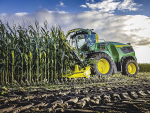As the weather warms and the grass moves skywards, many will be pulling their mowing equipment out of the shed, or maybe the nettles, with a view to be ready to start producing next winter’s feed.
Using a mower-conditioner enables faster drying and helps preserve valuable nutrients in the forage, but it’s important to understand how the process works, to set up the machine properly and achieve the best results.
Plants have stems that are designed to move water from the roots to the leaves, with a small surface area and a thicker cuticle that stops evaporation of the water. By contrast, leaves have a much greater surface area and a thinner epidermis, so dry out much faster than the stems.
Conditioner units are designed to abrade or crush the stems to encourage water loss and speed up the drying process, hopefully retaining key nutrients in the harvested crop. Conditioners fall into two types: swinging fingers or flails or the roller type.
Finger-type conditioners use plastic, nylon or steel fingers, that typically hit the crop at high speed and force it against an adjustable baffle in the conditioner hood. Powered by a secondary drive, sometimes with a choice of speed, conditioners of this type encourage a positive crop flow, alongside a high air flow that helps to propel the crop through the machine and back onto the ground. Ideally suited to most types of grasses, they are not recommended for clover-rich or lucerne crops as their aggressive nature can cause ‘leaf shatter’, leading to loss of nutrients.
Roller-type conditioners, as the name suggests, crushes the plant stems as they pass through between two rubber coated rollers, that are typically configured with interlocking raised ribs. Stems are cracked longitudinally to enable rapid evaporation of water.
In both systems, proper adjustment can have a major effect on the overall quality of the crop, depending on the type and volume of the crop being harvested.
In the case of flail-based systems, the intensity of the conditioning will depend on rotor speed and the distance between the flails and any baffle plate. In heavier crops, the baffle usually needs to be opened wider as the crop is likely to become over-conditioned because of flow restriction and typically lead to a pulpy mess. Whatever the conditions, a visual inspection should be undertaken to ensure all stems are damaged.
Roller-type systems typically use interlocking rubber coated rollers, with the conditioning effect dictated by roller speed, roller spacing and the tension on the spring system used to hold the rollers together. If adjusted to a wider spacing, the condition effect will be less or even non-existent. If, however, the spacing is too tight, crop flow will be restricted, and larger stems will not pass between the rollers and typically suffer a large degree of leaf loss. Ideally, the gap between the rollers should be slightly narrower than the average stem size of the crop.
It is also important to ensure that the co-ordination of the interlocking profile of the roller ribs is maintained (they often slip their timing if large items pass through the rollers) as any mis-timing can result in leaf damage or blockage and a resultant reduction in yield.
As a rule, visually inspect the conditioned crop and try to achieve 90% of the stalks being damaged. Also look at leaves closely, ensuring they are not turning black, which typically means they are being over-conditioned. This quickly leads to leaves turning white and falling to the ground in subsequent operations.
In addition to crop losses, poorly configured conditioners can lead to increased power demand and increased fuel consumption.


















